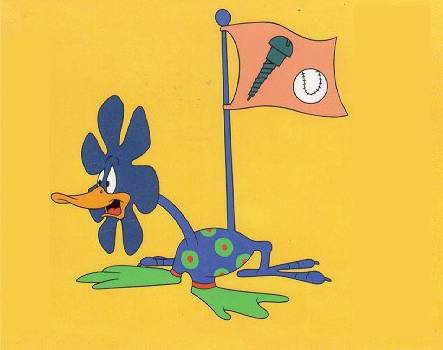
A film director, like an orchestra conductor, is the lord of his domain, and no director has more power than a director of animated films. He is set free from the rules of the physical universe and the limitations of human actors, and can tell any story his mind can conceive. That’s no doubt why Chuck Jones, after creating the characters of the Road Runner and Wile E. Coyote, immediately wrote down the rules of what could and could not happen in their universe. If anything could happen (and it could), the comedy would be lost in anarchy.
Jones and other masters of the cartoon short subject created a world apart from the real world and also apart from feature-length animation, which tended to be more story-driven. In their films, which were usually about 7 minutes long, comic scenarios were driven by eternal conflicts between a character and his desires: Elmer Fudd wanted to shoot a wabbit, and over and over he tried, and over and over he was outwitted (except once, as we will see).
There was a time when the feature was invariably preceded by a cartoon, and audiences smiled when they heard the theme music for “Looney Tunes” and “Merrie Melodies” from Warner Bros. Cartoons have long since been replaced by 20 minutes of paid commercials in many theaters, an emblem of the greed of exhibitors and their contempt for their audiences. In those golden days, the cartoon (and even a newsreel and a short subject) was a gift from the management.
There are several main lines in cartoon shorts: Disney (Mickey, Donald and Goofy), Warner Bros. (Bugs, Daffy, Elmer, Tweety and Sylvester, the Road Runner), MGM (Tom & Jerry) and UPA (Mr. Magoo). Many of these little films are available on DVD, lovingly restored (Roy E. Disney personally supervised a series of Disney classics, which come packaged in aluminum canisters). To choose one director or a few titles from the cartoon universe is daunting, but I’ll choose Chuck Jones, because I knew him and because three of his cartoons have been included in the National Film Registry of the Library of Congress: “Duck Amuck” (1953), “One Froggy Evening” (1955) and “What’s Opera, Doc?” (1957).
With commentary tracks, interviews and documentaries, the Warner Bros “Looney Tunes Golden Collections” on DVD surround the films with the legend and lore of Termite Terrace, where the animators and their writers and assistants labored in the 1930s and 1940s under the unloved producer Leon Schlesinger. He was an independent contractor supplying cartoons to Warners, and he required every animator (including Jones, Tex Avery, Friz Freleng and Bob Clampett ) to produce 10 cartoons a year, one every five weeks, with two weeks for vacation. Schlesinger sold out to Warners in the mid-40s, but lived on in the legends of the Termites.
I met Jones (1912-2002) and his wife, Marian, many times at the Telluride Film Festival, and spent a week with them on the QEII during Telluride’s 25th anniversary cruise. I heard again and again about Schlesinger, his cluelessness, his rigidity, his time clocks, and especially his weird Trumpian comb-over. “Leon never did figure out that he was the inspiration for Daffy Duck,” Jones chuckled. At last, in a 1940 Friz Freleng short named “You Ought to be in Pictures” in one of the Warner’s collections, I’ve seen Schlesinger for the first time, and, oddly enough, he looks a little like Elmer Fudd and yes, he has the most unconvincing hair I have ever seen.
The animators sometimes bent Schlesinger’s rules to make more ambitious cartoons. Working with Michael Maltese, the writer of all three of the National Registry cartoons, Jones knocked off a Road Runner short in three weeks flat to steal time for “One Froggy Evening,” which required extra attention for its singing and dancing frog. More time was needed, too, for “What’s Opera, Doc?” in which Elmer Fudd plays a Wagnerian warrior and Bugs Bunny, in drag with blond pigtails, is Brunnhilde.
Of the three titles, the strangest is “Duck Amuck,” which plays with the reality of the genre. In it Daffy Duck is aware he’s a character in a cartoon and shouts angry tirades against his animator, who strikes back with pencil, eraser and paint brush. Daffy begins as a dueling Musketeer but suddenly runs out of background and is marooned on an empty white screen. He demands a backdrop, and a brush enters the frame to paint a farm. Daffy, a trouper, starts singing “Daffy Duck, He Had a Farm.” But the backgrounds change with sadistic glee: snow, a beach in Hawaii. Then he is erased. He reappears with a guitar but cannot make his music heard, and holds up a sign saying “Sound, Please!” He gets a machine gun and a klaxon.
“I’ve never been so humiliated in my life,” Daffy complains. There’s more. He’s on a desert island that’s a speck in the distance. “Give me a closeup!” he demands. The island is framed in a small box surrounding the speck with black. “This is a closeup?” The camera zooms to his bloodshot eyes. Soon “The End” appears on the screen, and Daffy angrily pushes the letters offscreen and gets into a fight with curtains of black ink that threaten to obscure him. It’s a fight to the finish between a cartoon character and his medium, with a twist at the end when we find out who the animator is.
The subtext of “Duck Amuck” is Daffy’s desire to be the star of the studio, and his career-long rivalry with Bugs Bunny, who came along just as Daffy was becoming Warner’s star. In both “Duck Amuck” and “What’s Opera, Doc?” Jones gives himself freedom to rewrite cartoon conventions.
In the opera spoof, bits of half a dozen Wagner operas create a pastiche of romantic turmoil as Elmer woos Bugs. There are sensational shots (the opening lightning storm) and quieter moments that surprise us, as when Elmer Fudd seems sad and takes the plot seriously.
For the first time, we feel sorry for this creature who exists to be the foil of Bugs. There is a scene where Bugs appears to be dead, tears drop from a flower on a broken stem, and Elmer mourns, “Poor little wabbit.” Jones seems perilously close to breaking through the ritual of the Elmer-Bugs feud into the reality of their endless Sisyphean rivalry. At the end, amazingly, Elmer is not defeated, but strides off in his helmet and with his spear, the wabbit under his arm. Doesn’t that break all the rules?
Bugs then asks us, “Well, what did you expect in an opera? A happy ending?”
“One Froggy Evening” is a parable starting with the old joke about a guy with a talking frog. A construction worker opens a time capsule from a demolished building and finds a frog who puts on a top hat and dances while singing “Hello, My Ragtime Gal.” Later, he will perform an Irish ballad and the aria “Largo al factotum” from “The Barber of Seville.”
Dollar signs dance around the construction worker’s head as he imagines the frog as a box-office bonanza. But the frog will sing only for the worker; it clams up and goes limp when anyone else is listening. In despair, the worker seals the frog inside another time capsule, and we see it being discovered by another worker, a century in the future, who is also delighted by its act.
There are tragedies in conflict here: (a) a frog who is a song and dance star, who has been locked in the dark for decades but cannot perform in public, and (b) a worker who dreams of wealth and is considered a fool and a liar. The story of “One Froggy Evening” involves an endless loop of frustration. Jones bent the rules to sneak it around Schlesinger, and it was hailed as a masterpiece — so popular, that although the frog appeared in only one cartoon, he was later given a name (“Michigan J. Frog,” the middle initial in honor of Time magazine film critic Jay Cocks) and became a logo for the WB Network.
Cartoons were limited not only in length but in detail; they were made at a time when every frame had to be drawn by hand, and implacable producers like Schlesinger kept an eye on the time clock. Backgrounds tended to be static unless motion was essential; the animators focused on the characters, and it is remarkable what precision of behavior and personality they achieved. In body language, as much as in the voices supplied by such gifted artists as Mel Blanc, the characters expressed themselves, and to look at the elegant nonchalance of Bugs or the frenzied determination of Daffy is to see a universe of emotion conveyed in animation where economy met style.
These cartoons, and all the cartoons from the same tradition, seemed doomed to play for a week and then disappear (although sometimes there would be a collection of “Five Color Cartoons” before a kiddie matinee, and London’s Piccadilly Circus had a theater that played only cartoons). Then, just as the studios pulled the plug on cartoon shorts, color TV came along to give them a new life, and now on cable and DVD they seem immortal. There are two ways to regard them: As silly little entertainments, or as an art form that in its own small way, its limitations permitting an infinity of imagination, approaches perfection.
Thanks to reader Mark Kitchen, who suggested cartoons as Great Movies, and credit to the commentary tracks and supplementary material on the Warner Bros. “Looney Tunes Golden Collection” Vols. 1 and 2.




















